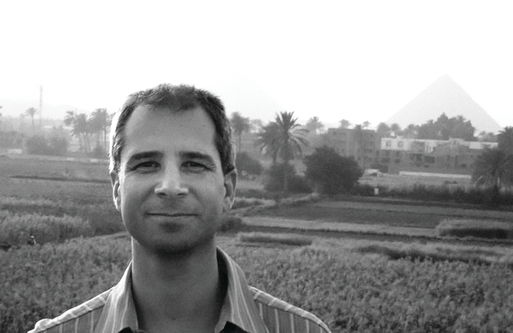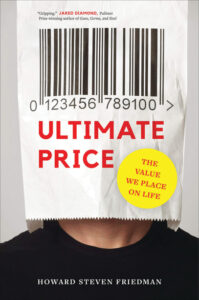
What is the worth of a human life? Most of us would probably say “priceless.” But in his new book, Ultimate Price: The Value We Place on Life (UC Press, 2020), renowned statistician, data scientist, and health economist Howard Friedman MS ’98, PhD ’99 examines all of the ways, hidden and overt, that we affix a finite value to human existence.
Every day, whether we know it or not, courts, insurance companies, governments, and manufacturers make decisions about how much each of our lives is worth. More important, says Friedman, those decisions often are based on questionable assumptions— that, for instance, age, race, gender, location, education, income, and other factors make some people’s lives worth more than others. And these assumptions tend to exacerbate existing inequalities.

The author or coauthor of a dozen books, Friedman has worked as a data scientist in the corporate, academic, and public sectors. He led teams of statisticians, analysts, and programmers at Capital One. Since 2007, he has served as a technical specialist for the United Nations, and he is currently an associate professor at Columbia University, where he teaches at both Columbia’s Mailman School of Public Health and Data Science Institute.
Friedman believes in the value of measurement, of data analytics, but hopes that shedding light on the unfairness inherent in many models we use to determine the value of a human life will inspire us to use these tools to instead promote equality.
Q: What inspired you to write Ultimate Price?
A: Many of us were touched in different ways after 9/11. Like many native New Yorkers, I know people who died that day. But when Congress created the September 11th Victim Compensation Fund, where dollar figures were put on people’s lives and some were deemed 30 times more valuable than others, it really struck a chord with me. Kenneth Feinberg, the attorney who was appointed to administer the fund, was saddled with the limitation that he had to assign an economic value to each life, and though he did his best to narrow the range, he nonetheless came up with a calculation in which the value of those lives ranged from $250,000 to more than $7 million. The existence of the fund as well as the broad range of payouts were both very controversial. Only a few years after he had administered that fund, Mr. Feinberg argued that it would have been simpler and more acceptable to have paid those 9/11 families the same amount of money for each victim, rich or poor, young or old. When he was later appointed to administer the compensation fund for the victims of the 2013 Boston Marathon bombing, he did exactly that, ensuring that the families of the victims were all paid the same amount. It was a real statement of equality, and a real tribute to his leadership and integrity to follow through on his own statements.
After 9/11, I started seeing that the way we value human life has been a common thread running through all of my work, and a few years ago, I realized there was a book there.
Q: What did you expect to find, and what surprised you?
A: I was well aware of inequality. It was a big theme in The Measure of a Nation [his 2012 book that compared American performance in health, education, safety, and other quality of life issues against the performances of 13 other industrialized nations].
But what surprised me was just how extreme the discrepancies are in how human life is valued. Look at the tragedy in Bhopal, India [the 1984 gas leak at a Union Carbide pesticide plant in which more than a half-million people were exposed to toxic fumes and many thousands died or were disabled], and how those lives were valued at tens of thousands of dollars. And contrast it to the more recent Toyota case [involving unintended acceleration], where the lives lost were valued at tens of millions of dollars each. There’s a difference in time and in the economic systems of the two countries, but not enough to explain the massive difference in magnitude.
The theme that runs through Ultimate Price is that lives that are less valued are less likely to be protected. And that’s where this goes from being an interesting theoretical exercise to a real-world fact—that if a company feels like they’re going to lose tens of millions of dollars per preventable death, they’re going to invest a lot more in safety than if they’re losing only tens of thousands.
The infamous Ford Pinto is a great example of this. Ford knew that the car, which it introduced and sold during the 1970s, could burst into flames if hit from behind but came up with what has since become a notorious cost-benefit analysis—which was leaked at the time to the press—designed to convince regulators that making the car safer would cost substantially more than the value of the human lives lost. Of course, they miscalculated. Even if you don’t consider the moral implications, the monetary cost assigned to those lives in the lawsuits that Ford faced for many years afterward, as well as the public outrage and its impact on their reputation, clearly exceeded anything it might have cost them to improve the safety of the car.
Q: What is your hope for the impact of your book?
A: I want to raise people’s awareness of the fact that price tags are put on life all the time, whether they be cost-benefit calculations affecting the safety of cars and other consumer products, jury awards in wrongful death suits, how health insurance companies decide what drugs and medical procedures to cover, and even how stringent regulators will be in assuring you clean air and water. I want people to know that these price tags are often unfair and that if you don’t address these inequities, you are going to have situations where people’s lives are put at risk unnecessarily.
U.S. regulatory agencies routinely perform cost-benefit analyses when they are creating and enforcing regulations, and it is generally the policy to value all lives equally in making those calculations. So there was a huge outcry when the George W. Bush administration proposed cutting the value of a senior life to about half the standard value. Opponents called it the “senior death discount,” and, in the face of that public outrage, the administration eventually backed down.
I want people to realize that they can understand these algorithms. Everyone doesn’t necessarily need to review the details of the equations, but you can understand the key assumptions, the key inputs, and the main outputs. I want people to know it’s OK to challenge experts. I’m not encouraging an anti-science approach—we have seen how dangerous and short-sighted that can often become. But I do encourage people to become informed, to learn enough about the science to go in and say, “You are assuming this. We don’t think it’s true. And here are the reasons why we challenge this assumption.” And then make the technical people defend their work. Maybe the scientists can defend the assumptions, or maybe there are opportunities to improve the modeling.
I’m not so idealistic as to think unfairness will magically disappear, but I do know that when enough people realize something is fundamentally unfair, they can take action and seek to address this inequity.
Q: How do you see your findings about inequality playing out in the COVID-19 pandemic?
A: It turns out that COVID is not the great equalizer but is, in fact, exacerbating inequality. In New York City, there was no question that people who could afford to rent or own a second home away from the city would fare much better than people who had to physically travel to their jobs, often on public transportation. Not just in New York, but in many places, minority groups often had much higher infection rates due to population tendencies related to employment, transportation requirements, and physical living environments.
And there are economic inequities. People in the most privileged positions are the most likely to be able to work remotely and the least likely to lose their jobs. And then there’s testing. When you heard that Tom Hanks and NBA players were able to get tested, while at the same time, most of us could not get tested, it was hard not to get the message that their lives are more valuable than the lives of the less wealthy and less privileged.
Q: What do you think of the projection models we’ve seen?
A: JHU is definitely leading in terms of having some of the highest-quality analytics work related to COVID, and I’m very proud of what they’ve done. On the other hand, some groups that got a tremendous amount of media attention produced models that were, at least initially, horrendously wrong in terms of their predictions.
The problem with making projections about the United States is we have so many local variations of behavior, and we don’t have true enforcement. It’s not just that we don’t have a collective policy; it’s that as a nation we don’t necessarily have a feeling of being collective, that we’re all in this game together, whether it’s COVID or life. I contrast it with a lot of the countries that have really had tremendous success—not just New Zealand, because it’s a small island and it’s different, but countries like Vietnam, where there’s a substantial population and they’ve been able to work as a society to aggressively control COVID-19. There are lots of best practices we could learn from other countries, and I wish, as a nation, we’d be willing. I just don’t think culturally we are that good at doing that. It’s what I argued in The Measure of a Nation. We tend to like to go our own way even when other countries are clearly, clearly doing massively better than we are.
One key take-home from the initial data on COVID mortality and economic impact is that the countries that have been the most successful at controlling COVID mortality are also more likely to have had better economic performance. It is a stark reminder that investing in public health is not only the right thing to do from a human rights perspective but also makes good economic sense.




